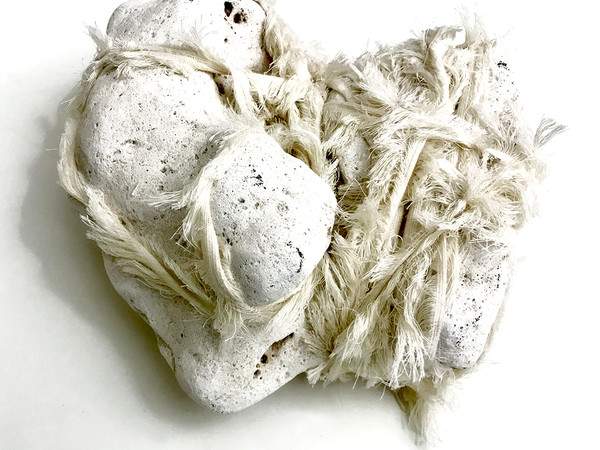Abbadia Lariana, Saba Najafi's textile works at the Civic Museum Setificio Monti
From Aug. 28 to Sept. 18, 2022, the Civico Museo Setificio Monti in Abbadia Lariana, in the province of Lecco, will host Refuge, a solo exhibition by Saba Najafi (Iran, 1979) curated by Erika Lacava, under the patronage of the Municipality of Abbadia Lariana.
Refuge is a project conceived for the Civico Museo Setificio Monti, the only example in Italy of the integral recovery of a 19th-century spinning mill. The museum, established in 1998 after the recovery of the spinning mill and silk spinning machine built by Pietro Monti in 1818 and 1869, respectively, is currently preserved in the state it was in in the mid-19th century, restored and enriched with coeval materials from other spinning mills that have now disappeared. The history of the Lecco area has been linked for centuries to silk activities, from silkworm breeding to cocoon spinning, twisting and weaving, of which Manzoni’s Lucia is the heir and iconographic emblem for these places. Saba Najafi gathers this local historical richness in order to relocate it in the present, enhancing on the one hand the different stages related to silk production and connecting them on the other hand to her country of origin, Iran, as a land of ancient passages of the historic Silk Road.
Through this double track, Lecco and the East, move the threads that shape the exhibition. In a continuous cross-reference of signs and symbols, Saba Najafi’s work moves from local to Iranian culture as in a weave of warp and weft, until it forms an elaborate and homogeneous fabric. Structured as a single site-specific installation, the exhibition spans the three aisles of the Museum’s ground floor playing with the main elements of the building, unfolding among the arches and time-shattered walls the motifs dear to the artist. In fact, reworkings of the latest series started in 2020 are exhibited here: Metamorphosis branches bound together by strips of fabric like medical bandages, Inner care, stones partially covered with fabric, and new elaborations of the series Stone as memories, in papier mâché with calligraphic inserts.
Strong is the reference to silk, and the reference to the Museum becomes gradually more explicit: the concept of the museum is in fact investigated in its value as a place of custody, archive and protection, expanded to include in itself the idea of home and identify with it. Starting with the vaults of the ceiling, reinforced by branches bent into an arch from which long strips of fabric descend, the ancient space is redesigned by the artist to transform it into a dwelling, a home, a refuge. In such a critical socio-political moment as the current one, the refuge offered by Saba Najafi is a shelter from war, injustice, anger, a hug for those who feel alone and helpless, the shade of a tree and coolness to counter desertification and climate change. A place where everyone can be comfortable and feel safe.
The materials used, which differ in color and texture, all belong to the natural environment and ideally reconstruct different types of dwellings: in the wooden structures, nests are found, in the stones, houses, in the fabric, the clothes we “inhabit” every day. The curvilinear development of the layout guides the visitor on a path to the central nave, the nerve center of the exhibition, above which is reconstructed a roof of wooden branches, the symbol of home, from which descends a cascade of filaments designed to welcome and protect it as in an embrace. The ancient fireplace in the room hints at the domestic hearth, while the papier mâché stones recall the cocoons that silkworms build around themselves, like a home.
In the third room, completing the exhibition, there is a video in which one can immerse oneself in the folds of the fabric, a small archive fit to house stones, as a symbol of the permanence of memory, and a large raw cotton knot to symbolize the bond and strength of memory.
The exhibition is realized thanks to the technical contribution of Tessilbusto of Busto Arsizio and is accompanied by a digital catalog, with critical text by Erika Lacava.
For all information, you can visit the official website of the Civic Museum Setificio Monti.
Pictured: Saba Najafi, Self-Portrait I (2020). Stone and cotton strips, 25x25x8 cm.
 |
| Abbadia Lariana, Saba Najafi's textile works at the Civic Museum Setificio Monti |
Warning: the translation into English of the original Italian article was created using automatic tools. We undertake to review all articles, but we do not guarantee the total absence of inaccuracies in the translation due to the program. You can find the original by clicking on the ITA button. If you find any mistake,please contact us.





























